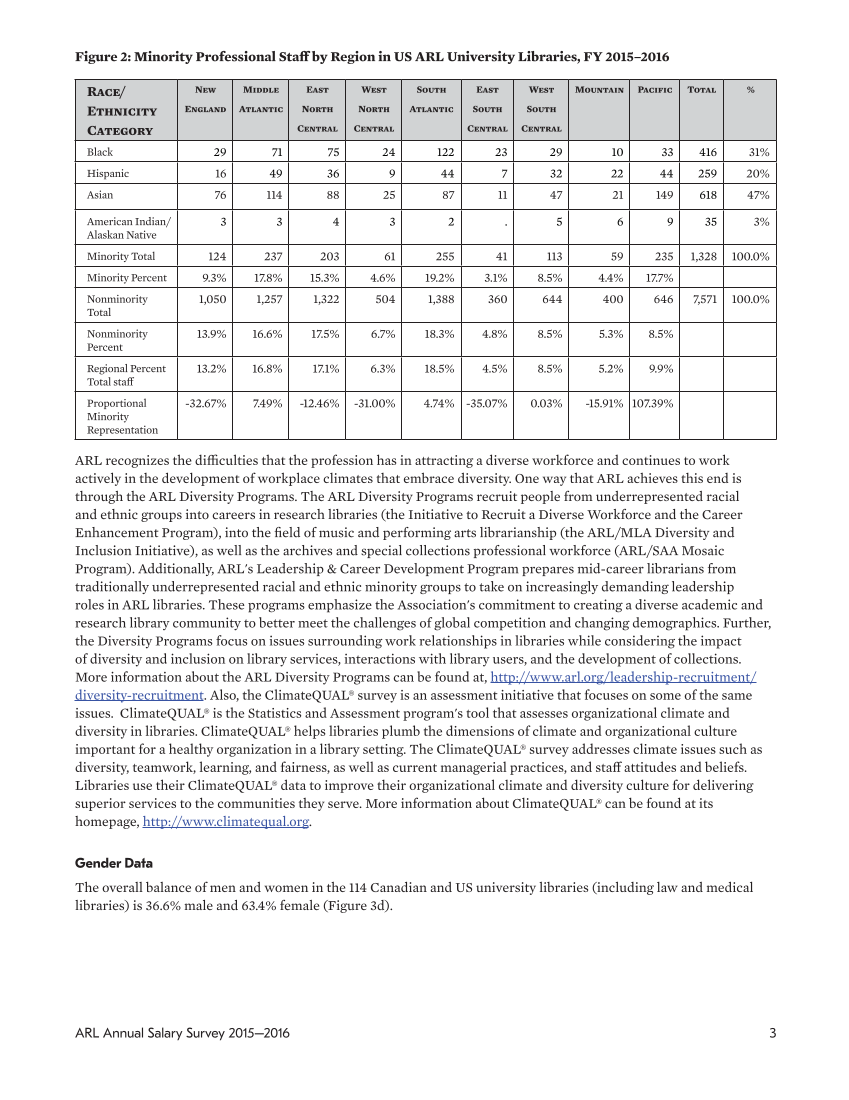3 ARL Annual Salary Survey 2015–2016 Figure 2: Minority Professional Staff by Region in US ARL University Libraries, FY 2015–2016 Race/ Ethnicity Category New England Middle Atlantic East North Central West North Central South Atlantic East South Central West South Central Mountain Pacific Total %Black 29 71 75 24 122 23 29 10 33 416 31% Hispanic 16 49 36 9 44 7 32 22 44 259 20% Asian 76 114 88 25 87 11 47 21 149 618 47% American Indian/ Alaskan Native 3 3 4 3 2 .5 6 9 35 3% Minority Total 124 237 203 61 255 41 113 59 235 1,328 100.0% Minority Percent 9.3% 17.8% 15.3% 4.6% 19.2% 3.1% 8.5% 4.4% 17.7% Nonminority Total 1,050 1,257 1,322 504 1,388 360 644 400 646 7,571 100.0% Nonminority Percent 13.9% 16.6% 17.5% 6.7% 18.3% 4.8% 8.5% 5.3% 8.5% Regional Percent Total staff 13.2% 16.8% 17.1% 6.3% 18.5% 4.5% 8.5% 5.2% 9.9% Proportional Minority Representation -32.67% 7.49% -12.46% -31.00% 4.74% -35.07% 0.03% -15.91% 107.39% ARL recognizes the difficulties that the profession has in attracting a diverse workforce and continues to work actively in the development of workplace climates that embrace diversity. One way that ARL achieves this end is through the ARL Diversity Programs. The ARL Diversity Programs recruit people from underrepresented racial and ethnic groups into careers in research libraries (the Initiative to Recruit a Diverse Workforce and the Career Enhancement Program), into the field of music and performing arts librarianship (the ARL/MLA Diversity and Inclusion Initiative), as well as the archives and special collections professional workforce (ARL/SAA Mosaic Program). Additionally, ARL's Leadership &Career Development Program prepares mid-career librarians from traditionally underrepresented racial and ethnic minority groups to take on increasingly demanding leadership roles in ARL libraries. These programs emphasize the Association's commitment to creating a diverse academic and research library community to better meet the challenges of global competition and changing demographics. Further, the Diversity Programs focus on issues surrounding work relationships in libraries while considering the impact of diversity and inclusion on library services, interactions with library users, and the development of collections. More information about the ARL Diversity Programs can be found at, http://www.arl.org/leadership-recruitment/ diversity-recruitment. Also, the ClimateQUAL® survey is an assessment initiative that focuses on some of the same issues. ClimateQUAL® is the Statistics and Assessment program's tool that assesses organizational climate and diversity in libraries. ClimateQUAL® helps libraries plumb the dimensions of climate and organizational culture important for a healthy organization in a library setting. The ClimateQUAL® survey addresses climate issues such as diversity, teamwork, learning, and fairness, as well as current managerial practices, and staff attitudes and beliefs. Libraries use their ClimateQUAL® data to improve their organizational climate and diversity culture for delivering superior services to the communities they serve. More information about ClimateQUAL® can be found at its homepage, http://www.climatequal.org. Gender Data The overall balance of men and women in the 114 Canadian and US university libraries (including law and medical libraries) is 36.6% male and 63.4% female (Figure 3d).






































































































































































